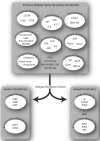Immune related genes underpin the evolution of adaptive immunity in jawless vertebrates
- PMID: 23024600
- PMCID: PMC3308329
- DOI: 10.2174/138920212799860670
Immune related genes underpin the evolution of adaptive immunity in jawless vertebrates
Abstract
The study of immune related genes in lampreys and hagfish provides a unique perspective on the evolutionary genetic underpinnings of adaptive immunity and the evolution of vertebrate genomes. Separated from their jawed cousins at the stem of the vertebrate lineage, these jawless vertebrates have many of the gene families and gene regulatory networks associated with the defining morphological and physiological features of vertebrates. These include genes vital for innate immunity, inflammation, wound healing, protein degradation, and the development, signaling and trafficking of lymphocytes. Jawless vertebrates recognize antigen by using leucine-rich repeat (LRR) based variable lymphocyte receptors (VLRs), which are very different from the immunoglobulin (Ig) based T cell receptor (TCR) and B cell receptor (BCR) used for antigen recognition by jawed vertebrates. The somatically constructed VLR genes are expressed in monoallelic fashion by T-like and B-like lymphocytes. Jawless and jawed vertebrates thus share many of the genes that provide the molecular infrastructure and physiological context for adaptive immune responses, yet use entirely different genes and mechanisms of combinatorial assembly to generate diverse repertoires of antigen recognition receptors.
Keywords: Adaptive immunity; Antigen receptor; Evolution; Jawless vertebrate; Leucine-rich repeat; Phylogeny; Somatic diversification; Variable Lymphocyte Receptor..
Figures



References
-
- Hoffmann J, Kafatos F, Janeway C, Ezekowitz R. Phylogenetic perspectives in innate immunity. Science. 1999;284(5418 ):1313–1318. - PubMed
-
- Medzhitov R. Recognition of microorganisms and activation of the immune response. Nature. 2007;449 (7164 ):819–26. - PubMed
-
- Janeway C, Travers P, Walport M, Shlomchick M. Immunobiology the immune system in health and disease. 5th. New York: Garland Science; 2001.
-
- Pancer Z, Amemiya C, Ehrhardt G, Ceitlin J, Gartland G, Cooper M. Somatic diversification of variable lymphocyte receptors in the agnathan sea lamprey. Nature. 2004;430 (6996 ):174–180. - PubMed
-
- Herrin B R, Cooper M D. Alternative adaptive immunity in jawless vertebrates. J Immunol. 2010;185 (3 ):1367–1374. - PubMed
Grants and funding
LinkOut - more resources
Full Text Sources
